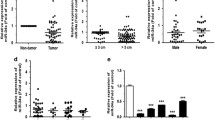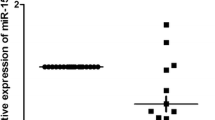Abstract
Background/aim
MicroRNAs play crucial roles in controlling cellular biological processes. miR-143 expression is usually downregulated in different cancers. In this study, we focused on exploring the role of miR143 in NSCLC development.
Methods
Bioinformatics analyses were used to detect the expression level of miR-143 in lung tumors. The cells were transfected by pCMV-miR-143 vectors. The efficacy of transfection was verified by Flow cytometry. The influence of miR-143 replacement on NSCLC cells migration, proliferation, and apoptosis was detected using wound-healing assay, MTT assay, and DAPI staining, respectively.
Results
MTT assay revealed that overexpression of miR143 inhibited cell growth and proliferation. Scratch assay results demonstrated that restoration of miR143 suppressed cell migration. The qRT-PCR assay was further used to detect the assumed relationship between miR143 and apoptotic and metastatic-related genes.
Conclusion
The findings showed that miR-143 could reduce cell proliferation, invasion, and migration by reducing CXCR4, Vimentin, MMP-1, Snail-1, C-myc expression level, and increasing E-cadherin expression levels in lung cancer cells and might be a potential target in NSCLC’s targeted therapy.





Similar content being viewed by others
Data availability statement
The data that support the findings of this study are available from the corresponding author upon reasonable request. Some data may not be made available because of privacy or ethical restrictions.
Abbreviations
- LC:
-
Lung cancer.
- SCLC:
-
Small cell lung carcinoma.
- NSCLC:
-
Non-small cell lung cancer.
- miRNAs:
-
MicroRNAs.
- miR-143:
-
microRNA-143.
- TCGA:
-
The Cancer Genome Atlas.
- G418:
-
Geneticin.
- FACS:
-
Fluorescence-activated cell sorting.
- DAPI:
-
2-(4-amidinophenyl)-6-indolecarbamidine dihydrochloride.
- M-MuLV RT:
-
Moloney murine leukemia virus.
- SD:
-
Standard deviation.
- NC:
-
Negative control.
- TS miRNA:
-
Tumor suppressor miRNA.
- OSCC:
-
Oral squamous cell carcinoma cells
- EMT:
-
Epithelial-mesenchymal transition
- MMP-1:
-
Matrix metalloproteinase 1
- MMPs:
-
Matrix metalloproteinase
References
Barta JA, Powell CA, Wisnivesky JP (2019)Global Epidemiology of Lung Cancer. Annals of global health, 85(1)
Herbst RS, Morgensztern D, Boshoff C (2018) The biology and management of non-small cell lung cancer. Nature 553(7689):446
Hosseinahli N et al (2018) Treating cancer with microRNA replacement therapy: A literature review. J Cell Physiol 233(8):5574–5588
Ivey KN, Srivastava D (2015) microRNAs as developmental regulators. Cold Spring Harbor perspectives in biology, 7(7): p. a008144
Ha M, Kim VN (2014) Regulation of microRNA biogenesis. Nat Rev Mol Cell Biol 15(8):509
Tavanafar F et al (2017) Restoration of miR-143 expression could inhibit migration and growth of MDA-MB-468 cells through down-regulating the expression of invasion-related factors, vol 91. Biomedicine & Pharmacotherapy, pp 920–924
Zhang N, Su Y, Xu L (2013) Targeting PKCε by miR-143 regulates cell apoptosis in lung cancer. FEBS letters. 587:3661–366722
Fan X et al (2013) Upregulated microRNA-143 in cancer stem cells differentiation promotes prostate cancer cells metastasis by modulating FNDC3B expression. BMC cancer. 13:611
Mallick R, Patnaik SK, Yendamuri S (2010)MicroRNAs and lung cancer: Biology and applications in diagnosis and prognosis. Journal of carcinogenesis, 9
Mollaei H, Safaralizadeh R, Rostami Z (2019) MicroRNA Replace therapy cancer J Cell Physiol 234(8):12369–12384
Zhang P et al (2022) MicroRNA-143 expression inhibits the growth and the invasion of osteosarcoma. J Orthop Surg Res 17(1):1–15
Yang H et al (2021) miR–143–3p inhibits endometriotic stromal cell proliferation and invasion by inactivating autophagy in endometriosis. Molecular medicine reports. 23:1–95
Zhang C et al (2021) MiR-143-3p Inhibits Cell Proliferation in Pedatric Acute Myeloid Leukemia via Inhibition of KAT6A. Pediatric Hematology and Oncology, pp 1–11
Ding C et al (2022) The anti-cancer role of microRNA-143 in papillary thyroid carcinoma by targeting high mobility group AT-hook 2. Bioengineered. 13:6629–66403
Peng J et al (2021) miR-143-3p inhibits proliferation and invasion of hepatocellular carcinoma cells by regulating its target gene FGF1. Clinical and Translational Oncology. 23:468–4803
Tang J et al (2021) MiR-495-3p and miR-143-3p co-target CDK1 to inhibit the development of cervical cancer. Clinical and Translational Oncology. 23:2323–233411
Asghariazar V et al (2022) Restoration of miR-143 reduces migration and proliferation of bladder cancer cells by regulating signaling pathways involved in EMT. Molecular and Cellular Probes. 61:101794
Mohammadi A et al (2021) Restoration of miR-330 expression suppresses lung cancer cell viability, proliferation, and migration. J Cell Physiol 236(1):273–283
Asghariazar V et al (2019) Tumor suppressor microRNAs in lung cancer: An insight to signaling pathways and drug resistance. Journal of cellular biochemistry
Karimi L et al (2017) Function of microRNA-143 in different signal pathways in cancer: New insights into cancer therapy, vol 91. Biomedicine & Pharmacotherapy, pp 121–131
Wu B-L et al (2011) MiRNA profile in esophageal squamous cell carcinoma: downregulation of miR-143 and miR-145. World J Gastroenterol 17(1):79–88
Liu L et al (2012) miR-143 is downregulated in cervical cancer and promotes apoptosis and inhibits tumor formation by targeting Bcl-2. Molecular medicine reports. 5:753–7603
Xia C et al (2018) MiR-143-3p inhibits the proliferation, cell migration and invasion of human breast cancer cells by modulating the expression of MAPK7. Biochimie, 147: p. 98–104
Xia H et al (2014) miR-143 inhibits NSCLC cell growth and metastasis by targeting Limk1. Int J Mol Sci 15(7):11973–11983
Karimi L et al (2019) miRNA-143 replacement therapy harnesses the proliferation and migration of colorectal cancer cells in vitro. Journal of cellular physiology
Chen X et al (2009) Role of miR-143 targeting KRAS in colorectal tumorigenesis. Oncogene 28(10):1385
Mesgarzadeh AH et al (2019) Transfection of microRNA-143 mimic could inhibit migration of HN-5 cells through down-regulating of metastatic genes. Gene, 716: p. 144033
Hu Y et al (2012) miR-143 inhibits the metastasis of pancreatic cancer and an associated signaling pathway. Tumor Biology. 33:1863–18706
Pozzobon T et al (2016) CXCR4 signaling in health and disease. Immunology letters, 177: p. 6–15
Chatterjee S, Azad BB, Nimmagadda S (2014) The intricate role of CXCR4 in cancer, in Advances in cancer research. Elsevier, pp 31–82
Yu T et al (2014) MicroRNA-9 inhibits the proliferation of oral squamous cell carcinoma cells by suppressing expression of CXCR4 via the Wnt/β-catenin signaling pathway. Oncogene, 33(42): p. 5017–5027
Luo X et al (2018) Wnt inhibitory factor-1-mediated autophagy inhibits Wnt/β-catenin signaling by downregulating dishevelled-2 expression in non-small cell lung cancer cells. Int J Oncol 53(2):904–914
Cano A et al (2000) The transcription factor snail controls epithelial–mesenchymal transitions by repressing E-cadherin expression. Nat Cell Biol 2(2):76
Diepenbruck M, Christofori G (2016) Epithelial–mesenchymal transition (EMT) and metastasis: yes, no, maybe? Current opinion in cell biology, 43: p. 7–13
Chen T et al (2017) Epithelial–mesenchymal transition (EMT): a biological process in the development, stem cell differentiation, and tumorigenesis. J Cell Physiol 232(12):3261–3272
He M et al (2017) MiR-143-5p deficiency triggers EMT and metastasis by targeting HIF-1α in gallbladder cancer. Cell Physiol Biochem 42(5):2078–2092
Peng X et al (2011) Identification of miRs-143 and-145 that is associated with bone metastasis of prostate cancer and involved in the regulation of EMT. PloS one. 6:e203415
Jackstadt R, Hermeking H (2015) MicroRNAs as regulators and mediators of c-MYC function. Biochimica et Biophysica Acta (BBA) - Gene Regulatory Mechanisms. 1849:544–5535
Zhang Y et al (2015) Sp1 and c-Myc modulate drug resistance of leukemia stem cells by regulating survivin expression through the ERK-MSK MAPK signaling pathway. Molecular cancer. 14:561
Chen Z et al (2010) miRNA-145 inhibits non-small cell lung cancer cell proliferation by targeting c-Myc. J Experimental Clin Cancer Res 29(1):151
Dong Y, Hu T (2018) Effects of miR-143 overexpression on proliferation, apoptosis, EGFR and downstream signaling pathways in PC9/GR cell line. cell. 80:4
Hossian A et al (2018) Multipronged activity of combinatorial miR-143 and miR-506 inhibits lung cancer cell cycle progression and angiogenesis in vitro. Scientific reports. 8:1–141
Liu M et al (2016) MMP1 promotes tumor growth and metastasis in esophageal squamous cell carcinoma. Cancer letters. 377:97–1041
Kuliopulos A, Koukos G (2016) PAR-1 activation by metalloproteinase-1 (MMP-1). Google Patents
Bibby BA et al (2019) Silencing microRNA-330-5p increases MMP1 expression and promotes an invasive phenotype in oesophageal adenocarcinoma. BMC Cancer 19(1):1–11
Caley MP, Martins VL (2015) O’Toole, Metalloproteinases and wound healing. Advances in wound care. 4:225–2344
Jiang Q et al (2019) Therapeutic delivery of microRNA-143 by cationic lipoplexes for non-small cell lung cancer treatment in vivo. J Cancer Res Clin Oncol 145(12):2951–2967
Ma Q et al (2013) MicroRNA-143 inhibits migration and invasion of human non-small-cell lung cancer and its relative mechanism. International journal of biological sciences, 9(7): p. 680
Shen Pf et al (2014) MicroRNA-494‐3p targets CXCR4 to suppress the proliferation, invasion, and migration of prostate cancer. Prostate 74(7):756–767
Ma F et al (2017) MiR-361-5p inhibits glycolytic metabolism, proliferation and invasion of breast cancer by targeting FGFR1 and MMP-1. J Experimental Clin Cancer Res 36(1):158
Acknowledgements
The current study was performed with the financial assistance of Tabriz University of Medical Science, Tabriz, Iran (grant number 60131).
Author information
Authors and Affiliations
Contributions
Vahid Asghariazar wrote the original paper and carried out the experiments, Behzad Mansoori and Mahtab Kadkhodayi contributed to data collection; Elham Safarzadeh and Ali Mohammadi provided advice and consultation; Behzad Baradaran and Ebrahim Sakhinia contributed to the final revision of the manuscript, analyzed the statistical data and verified the accuracy of the tests. All authors read and approved the final version of the manuscript.
Corresponding author
Ethics declarations
Ethical approval
This article does not contain any studies with human participants or animals performed by any of the authors.
Declaration of interest
The authors declare that there is no conflict of interest. The authors alone are responsible for the accuracy and integrity of the paper content.
Additional information
Publisher’s note
Springer Nature remains neutral with regard to jurisdictional claims in published maps and institutional affiliations.
Electronic supplementary material
Below is the link to the electronic supplementary material.


Rights and permissions
About this article
Cite this article
Asghariazar, V., Mansoori, B., Kadkhodayi, M. et al. MicroRNA-143 act as a tumor suppressor microRNA in human lung cancer cells by inhibiting cell proliferation, invasion, and migration. Mol Biol Rep 49, 7637–7647 (2022). https://doi.org/10.1007/s11033-022-07580-1
Received:
Revised:
Accepted:
Published:
Issue Date:
DOI: https://doi.org/10.1007/s11033-022-07580-1




